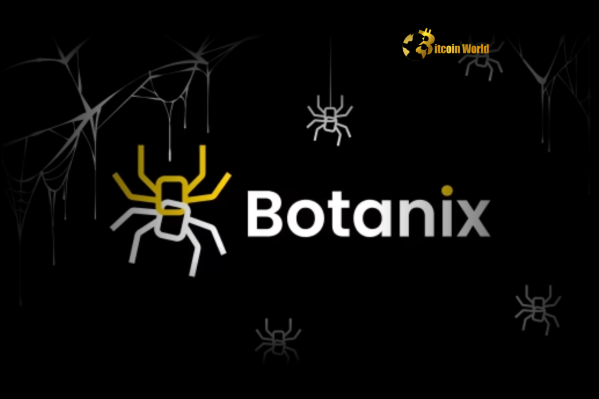BitcoinWorld

Botanix Labs Makes Pivotal Federated Model Shift for Bitcoin Layer-2
Big news from the world of Bitcoin layer-2 solutions! Botanix Labs, a project focused on bringing more functionality to the Bitcoin network, has just announced a significant strategic move ahead of its anticipated mainnet launch. This development is set to impact how the protocol operates and its path toward greater decentralization, a key goal for any blockchain project.
What is Botanix Labs and Why Does a Federated Model Matter?
At its core, Botanix Labs is building a Bitcoin layer-2 network. Think of it as an overlay on top of Bitcoin that aims to overcome some of Bitcoin’s inherent limitations, particularly when it comes to running complex applications. Their unique approach utilizes a technology called Spiderchain, which is designed to enable compatibility with the Ethereum Virtual Machine (EVM). This means developers could potentially deploy applications and smart contracts similar to those found on Ethereum, but secured by the underlying power of Bitcoin.
The shift to a Federated model is a crucial step in this journey. Previously, Botanix Labs might have held more centralized control over the network’s operations. A federated model, in this context, means handing over operational control and validation responsibilities to a group of independent, trusted entities. This moves the network away from being solely controlled by the founding team and distributes power among multiple participants.
Leading Operators Join the Federated Model
A major highlight of this transition is the caliber of the initial participants in the Federated model. Botanix Labs has brought on board 16 independent node operators. These aren’t just random individuals; they include established names in the cryptocurrency and blockchain space. According to reports, prominent entities like AntPool, Fireblocks, and Galaxy are among this initial group. The involvement of such recognized players lends credibility and operational expertise to the network.
Adding these independent operators removes Botanix Labs itself from direct operational control over the network’s consensus or validation processes. This is a vital step towards decentralization, making the network less susceptible to single points of failure or control by one entity. As they prepare for the upcoming mainnet launch, having a diverse group of operators already participating in the Federated model is a strong signal of their commitment to building a robust and distributed network from the outset.
Spiderchain and Enabling EVM Smart Contracts on Bitcoin
The underlying technology making all of this possible is the Spiderchain. This innovative architecture is what allows Botanix Labs to bridge the gap between Bitcoin’s security and the flexibility of EVM smart contracts. By enabling EVM smart contracts on Bitcoin, Botanix Labs aims to unlock a vast array of potential use cases, from decentralized finance (DeFi) applications to NFTs and more, all while inheriting Bitcoin’s unparalleled security guarantees.
The Federated model plays a direct role here too. These independent node operators are crucial for the operation and security of the Spiderchain. They will be responsible for validating transactions and maintaining the state of the layer-2 network, ensuring that the EVM smart contracts function correctly and securely, anchored by the Bitcoin base layer.
Why This Matters for the Mainnet Launch
The transition to a Federated model is more than just a technical tweak; it’s a foundational step necessary before the mainnet launch later this quarter. Launching a decentralized network requires distributed control from day one. By establishing this group of 16 independent operators now, Botanix Labs is setting the stage for a more resilient and decentralized network when it goes live for public use.
The goal is not to stop at 16 operators. Botanix Labs has stated plans to expand to hundreds of globally distributed validators over time. This gradual expansion of the Federated model is key to ensuring long-term decentralization and network resilience against various threats.
Benefits of the Federated Model Shift:
- Enhanced Decentralization: Reduces reliance on the core Botanix Labs team for network operations.
- Increased Resilience: Distributes control across multiple independent entities, making the network more robust.
- Preparation for Scale: Establishes a framework for onboarding a larger number of validators for the mainnet.
- Credibility: Involvement of recognized industry players adds trust and confidence in the network’s operational integrity.
- Alignment with Bitcoin Ethos: Moves towards a more distributed control structure, aligning with the decentralized nature of Bitcoin itself.
What’s Next for Botanix Labs?
With the Federated model now in place and initial operators onboarded, the focus is clearly on the impending mainnet launch. This shift is a critical milestone, demonstrating progress towards a decentralized operational structure required for a public network. The success of the Bitcoin layer-2, its ability to support EVM smart contracts via the Spiderchain, and its overall adoption will heavily depend on the robustness and decentralization achieved through this Federated model and the subsequent expansion of its validator set.
Summary
Botanix Labs has taken a significant step by transitioning to a Federated model and onboarding 16 independent node operators, including industry heavyweights. This move removes the core team from operational control, bolstering decentralization and network resilience. Utilizing the Spiderchain to enable EVM smart contracts on Bitcoin, this strategic shift is crucial preparation for their highly anticipated mainnet launch later this quarter. It signals a strong commitment to building a decentralized and robust Bitcoin layer-2 solution.
To learn more about the latest Bitcoin layer-2 trends, explore our article on key developments shaping Bitcoin smart contract capabilities.
This post Botanix Labs Makes Pivotal Federated Model Shift for Bitcoin Layer-2 first appeared on BitcoinWorld and is written by Editorial Team





